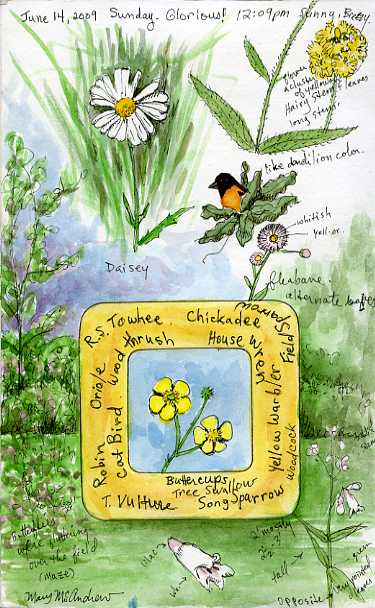
field-study-flowers
Clockwise from the top left you can see a Daisey in the grass, then the male Oriole popping his head through the oak leaves at the top of a VERY high old oak. Above that a yellow wildflower that I think is ‘King Devil’ a type of Hawkweed, then ‘Fleabane’, the little pink flower underneath the Oriole. The bottom right is a very pretty wildflower that I found in the Maze..anyone help me with this one? (I have photos of these wildflowers coming up.) In the frame are ‘Common’ or ‘Tall Buttercups’ and around the frame I listed the names of birds I saw or heard today.
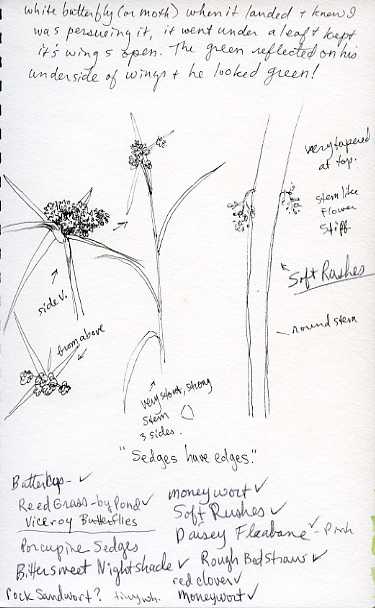
field-study-grasses
On the second page I just used the micron permanent pen and drew some grasses. On the right are ‘Soft Rushes’, their pliable stems are what would be used to weave mats or baskets and next to it some type of sedge. The rushes are more closely related to lilies than grasses, my field guide says and I know the stem is round. It’s neat to follow the stem to the top with your fingers and feel how absolutely perfect a point it comes to. The sketch next to it is of some type of sedge, honestly I can’t find it in my guide. They had a most interesting design in their growth, three leaves jutting out from the top in different directions and the clustered seed pods looking like spikey critters! It had a triangular stem which reminds me of the saying…”Sedges have edges”.
I snapped this shot as I was leaving the yard, just after his mom or dad had visited the hole. What a face! haha!
And here’s the pretty pink ‘Daisy Fleabane’, people used to hang it in their houses to keep away the fleas…not sure if it worked! I have a big clump of these sprouted up in my front flower bed and they are really pretty. Many people would have yanked it thinking ‘weed’, but well, it has lots of company with all the other weeds!
This is the mystery flower, can anyone help me identify it? I love the fine fuzz on it, as I look at a close up picture, it catches the sun. They were growing together in a patch in the middle of the Maze.
I think this is called King Devil a type of Hawkweed; I found it growing at ‘Aspen Hall’ a shady area along the lane just before the Maze. It has fine bristly hairs all over it and the flowers were all confined to just the top of one long stem. I had to move grasses to find the leaves, which were tucked low at ground level.
This white moth was interesting to study. I spotted him when Ginger and I were returning along ‘Oak Lane’, it was flitting eratically along the path, as butterflies do. I kept following it to try and get a picture and I’m sure it knew it was being followed. I thought about how strange it is for a WHITE butterfly to be amonst so much green! It stands out like a sore thumb, well I have a feeling this photo will teach you something. When it landed instead of staying on top of the leaf and closing it’s wings, it very quickly flipped under the leaf and laid it’s wings out. Now you’d think oh I’ll still see the white, but no, the green leaf reflected on it’s wings and it now looked green! How cool is that? If you ask questions as you stand and watch the bugs and critters around you, you’ll start to notice details you never thought of before.
Here is the gloriously beautiful male Baltimore Oriole! I love seeing them, such an intense orange and yellow breast set off by deep black like velvet! He’s way up in an oak tree looking down at me, can you tell? I love this picture of him. This was along Oak Lane and I ended up standing still here for quite a long time. I kept hearing several different birds give their warning chirp like they had babies near.
I’m glad I stood as long as I did, I caught sight of what I guessed was a female Oriole and studied where she disappeared to. Aha! They have a nest way up in the oak tree, hanging out over the path! It’s amazing that birds can actually weave a basket nest like this in the tree and it supports the eggs and adult, later all growing into heavier fledglings. If you look close you can just see the female through the leaves, leaning down into the nest to feed the babies.
I think this little green guy who came to visit me while I was eating and painting was really neat! I haven’t found him yet in my field guide, I think I need another bug guide to cross reference.
And last we have a very black, very shiney beetle…no I don’t think it’s this beetle but I’d love to hear some suggestions? Closest I’ve come is either a ‘Ground Beetle’, or ‘Red Legged Ham Beetle’ or a ‘Blue Milkweed Beetle’.
I hope you enjoyed the walk with me today, so much was seen and discovered in what looks just like an ordinary field and woodland edge. Take time to stand or sit still and just watch what the creatures around you do. And you’ll see so much more if you look a bit closer at the ground, grasses or flowers as there is always something living there.
Please post a comment if you like and if you may know what my bugs or flowers are, please lets have a stab at it!
Here’s the books I referenced after my hike today:
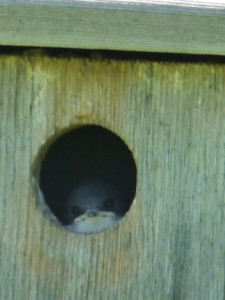
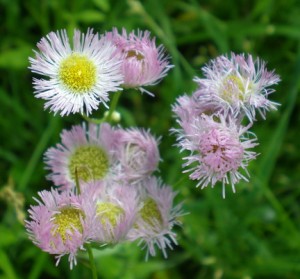
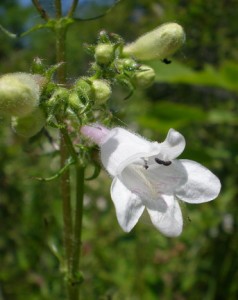

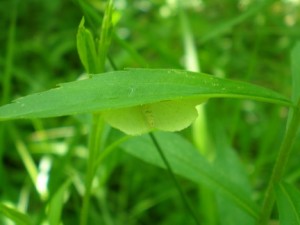
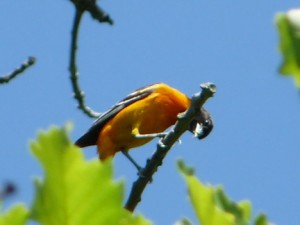
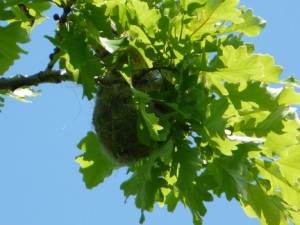
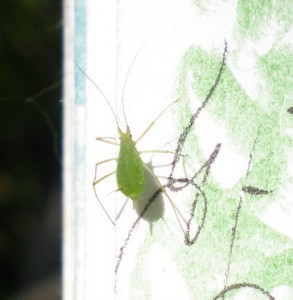
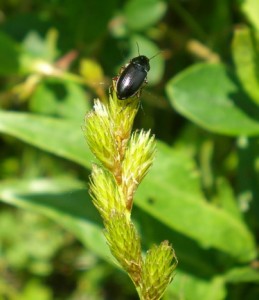
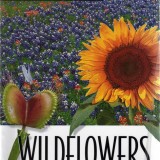
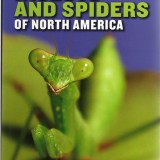
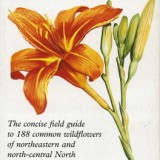
I am enjoying your blog and your sketching. I was amazed at the photo of the Baltimore Oriole. I admit – I haven’t seen one of those for over 50 years! What a treat to see a photo of one that you have seen! I was born in Annapolis, Maryland, and, even as a young child, it was a rarity to see one in our locale.
Thank you for the details that you share about your sketches, the colors and identification of the plants and grasses. It is quite helpful to me.
Well thanks so much Frankye! I was so happy catching that picture and actually got a few nice shots that day. I chose to share this one because I liked the way he looked down at me, like “hey, what’ya looking at?” I didn’t see them much as a child either, in Endicott, NY, near Binghamton. I just love the gorgeous color of the male and want to do a ‘real’ painting of him someday.
I’m glad you like the details about how I do things, or my experiences in the field. I’m not a professional writer but do enjoy it! I guess if you like nature, you like to learn about other’s findings.
Glad you’re following me here. New post coming soon!
We found this white flower that you are calling a mystery flower. and did an image search which brought us to your page. We think it is a beard-tongue, genus penstemon.
Thanks so much Molly for posting this info to me here! I packed away all my wildflower guides because I’m moving but hope to look it up later. I find so many interesting flowers and bugs while I’m walking that I wish I had an army of experts with me to tell me what they are!
The white mystery flower could be Foxglove Beardtongue, not Foxglove or Beardtongue but Foxglove Beardtongue…or was it Beardtongue Foxglove!
Thank you ‘K’ for the possible id on the white flower! It was such an unusual find on my land at the time, it was the only one of it’s kind there in the field! Now I’m living in England and have all different flowers to learn! Keep visiting for more!